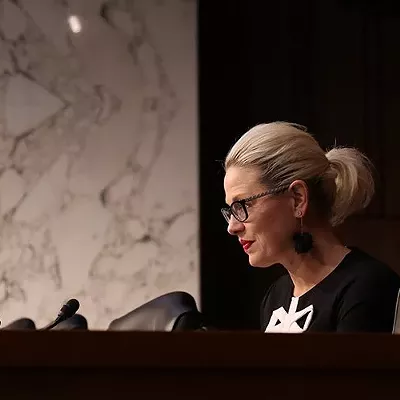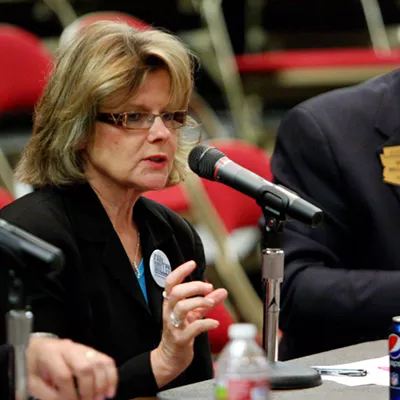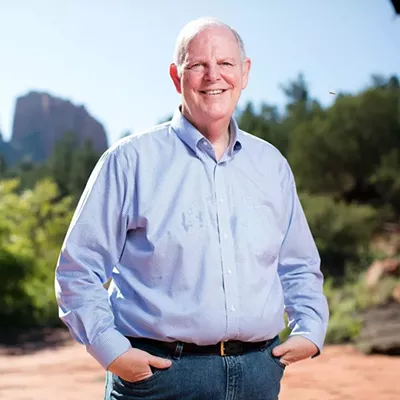In February, Congress approved the American Recovery and Reinvestment Act, a humungous bill meant to rescue our tanking economy with $787 billion in government spending. From that sum, $420 million was channeled toward upgrading 43 ports of entry. And by March, Homeland Security Secretary Janet Napolitano had announced that nearly half—$199 million—would find its way to bustling little Nogales, on the Arizona-Mexico border south of Tucson.
Subsequent charges of favoritism were not dampened by the fact that, prior to her current gig, Napolitano was Arizona's governor. The secretary, however, has denied these charges.
Still, even in the shadow of business as usual, small controversies can sizzle. Sometimes, they even offer precious glimpses into how the sausage gets made. Such an opportunity was recently brought to our attention by a faithful reader with a bit of inside information regarding the U.S. Department of Agriculture.
The USDA has about 10 staffers in Nogales who identify, analyze and sometimes quarantine agricultural products entering the country. Currently, the agency pays $130,000 to lease two properties in Nogales for its labs and plant inspection tasks.
But when the new port is built, staffers will relocate there—at an annual cost of $837,000. That's a major rent hike, in a town filled with sufficient warehouses.
So what gives? According to some critics, the push for consolidating services at the port comes from the Fresh Produce Association of the Americas, a powerful, Nogales-based trade group representing 125 produce dealers, brokers and distributors who import Mexican fruits and vegetables. Big money is at stake: In Nogales, produce has grown into a $2 billion industry.
It's unclear how much arm-twisting went into moving the USDA operation to the port, which would theoretically speed the processing of northbound shipments by having all government inspectors under one roof. But association representatives did travel to Washington, D.C., in September, says J.B. Manson, a produce broker who also chairs the Greater Nogales and Santa Cruz County Port Authority, a nonprofit group of business and local government leaders who lobby for port improvements.
While Manson denies that the USDA is relocating under pressure from his industry, he's hardly unhappy with the prospect. "As a customs broker, I would think that's beneficial to have everybody under one location," he says. "Why? Because you want clearance through all federal agencies at one time."
Jessica Wasserman is a Washington, D.C.-based lobbyist for the Fresh Produce Association. She also dismisses claims that the group put on pressure for the USDA move. The association "has been working on (the Mariposa project) since way before the stimulus package," she says. "They've been working on it for years."
But to Lee Maril, the pricey USDA plan bears all the signs of pure pork. Maril is a sociology professor at East Carolina University in Greenville, N.C., who tracks border spending and security issues. He says much of the communication within modern ports is done by telephone, which means everyone doesn't necessarily need to work side by side. "It's hard to believe that the USDA couldn't continue with that. So taxpayers would want to know whether it's worth $700,000 for them to be at the port. That's about $70,000 per employee. And they're still going to phone each other, even in the same building."
Still, the pending arrangement doesn't surprise him. "That's the history of (U.S. Customs and Border Protection) and Homeland Security in general," Maril says. "They've wasted an awful lot of money."
But government officials defend the USDA move, saying that current Nogales facilities are short on space and other modern accoutrements.
The new port is targeted for completion in 2013. Then the "landlord" will be the General Services Administration, a federal agency that manages government properties, among other things. In an e-mail to the Tucson Weekly, GSA spokeswoman Gene Gibson claims that the change will actually reduce costs.
"While it is true that USDA will be renting the new space at Mariposa for approximately $1 million per year," Gibson writes, "it is important to note that the move to Mariposa will ultimately result in cost savings due to co-location and shared services at the site.
"The new and expanded USDA space at the Mariposa Land Port of Entry will include professional veterinary space with secondary holding facilities, a bath and shower, processing facilities for inspection of large and small specimens, a modern laboratory facility, and office space. USDA absolutely needs upgraded and renovated space at this time in any case, and the Mariposa move gives USDA the opportunity to take possession of modern, up-to-date space, while improving efficiency and security at the same time."
USDA spokeswoman Andrea McNally argues that annual costs for port space "will continue to decrease each year, because the figure includes not only the rent but also the build-out costs, parking spaces for government vehicles, dock space, janitorial and maintenance services, and DHS security fees. So once the build-out costs are paid, the figure will decline significantly, since it will only be for annual rent."
McNally is unable to pinpoint exactly how significant that decline will be. Regardless, she says the extra room available at Mariposa is a must. "They need space to unload trucks, to quarantine any product that's in question, to keep that product separate from anything that may have been cleared."
Given all of those considerations, "the current location is inadequate for meeting those needs and requirements."
It's unclear whether other agencies will be following suit and moving into the expensive new facility—or even what they're paying for their current Nogales offices. For instance, 11 employees with the Food and Drug Administration already at Mariposa will be moving to the new building, says FDA spokesman Christopher Kelly. They'll be joined by five others currently located elsewhere in Nogales, and an additional two employees. That raises the staff total—including screeners—to 18.
But getting a handle on how many taxpayer dollars are going toward current and future FDA leases isn't so easy. Kelly refuses to provide this basic information, instead advising us to file a formal Freedom of Information Act request. Such requests can take weeks to fulfill.
So much for government transparency.










